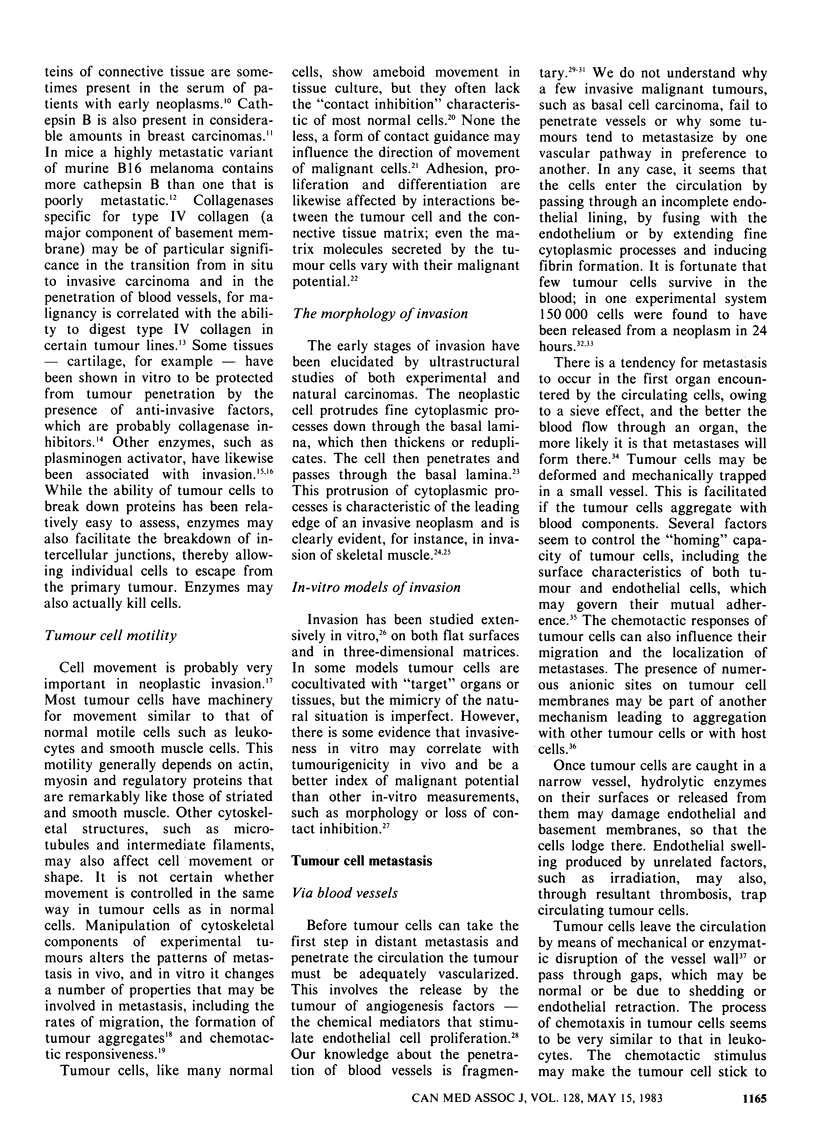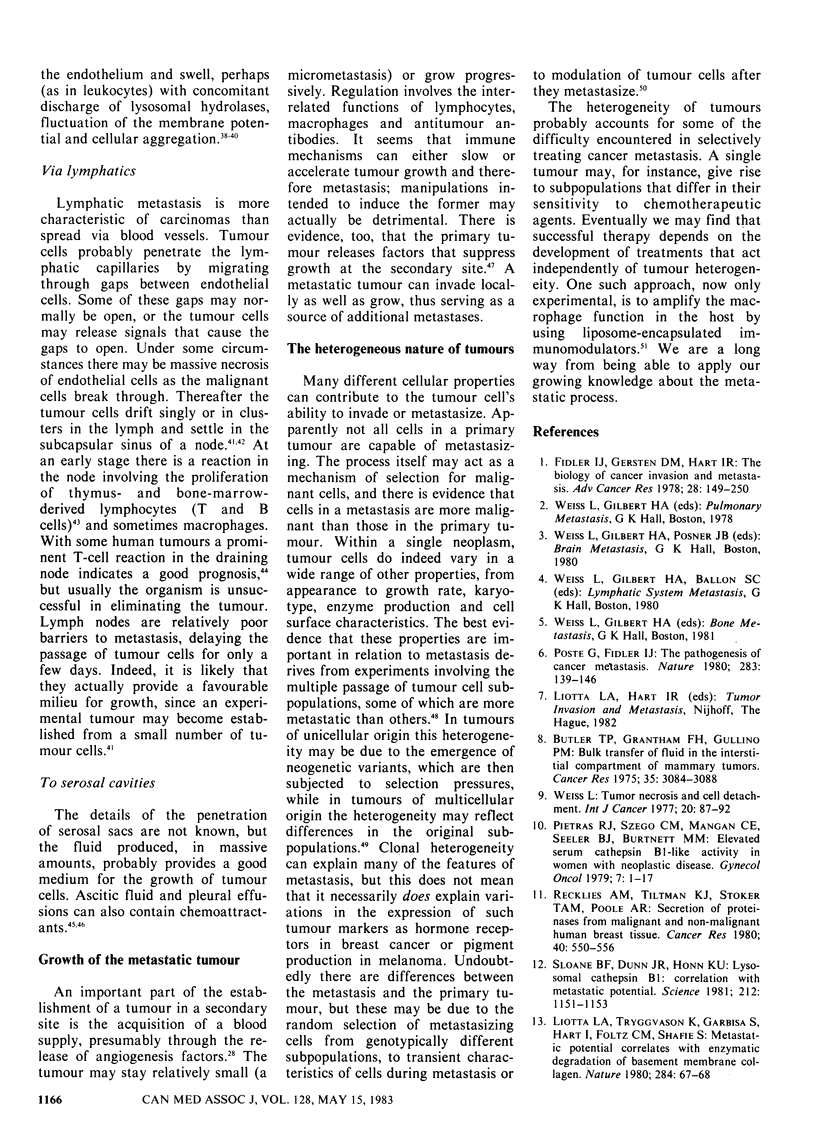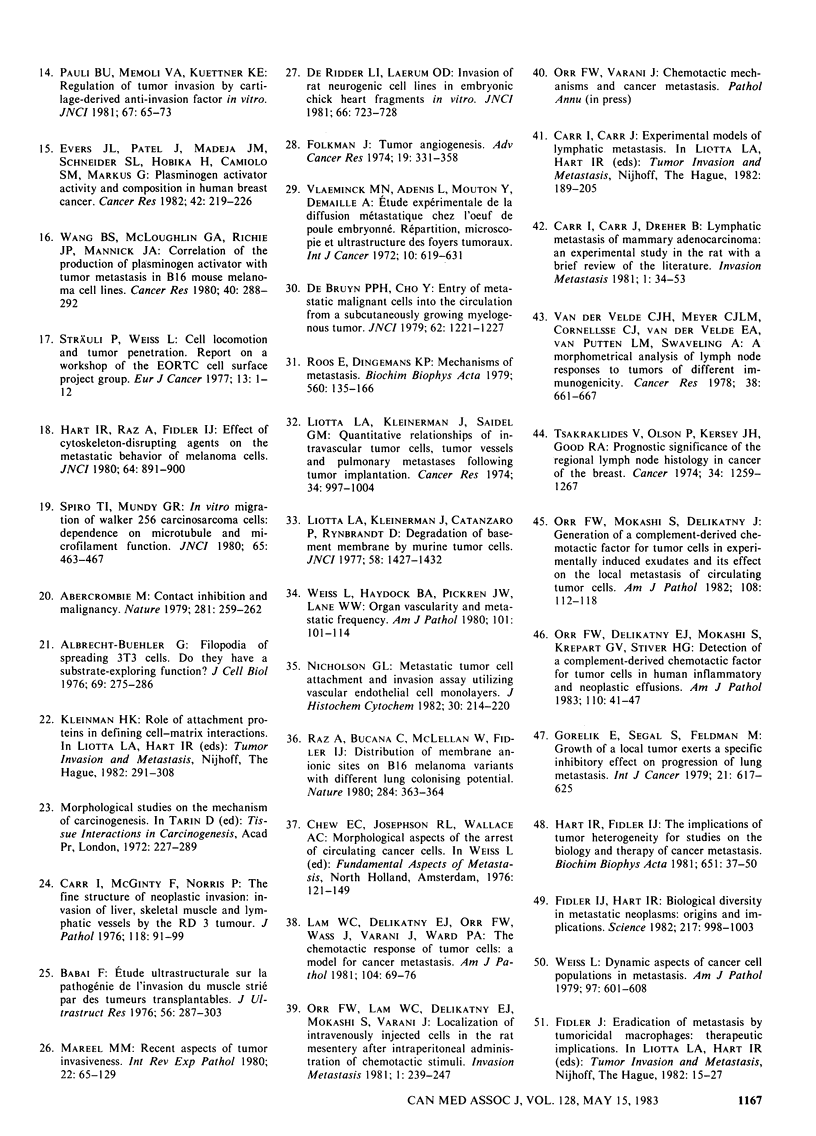Abstract
Malignant tumours cause sickness and death largely because they invade and metastasize. Such spread is made possible by many cellular properties, including the ability of neoplastic cells to move and to release degradative enzymes. These properties enable tumour cells to break free of the primary tumour, penetrate blood or lymphatic vessels and, after being transported to distant sites, pass out of the vessels to establish new tumours. Not all cells in a tumour, however, are able to metastasize, so the process tends to select for greater malignancy in the secondary tumour. The heterogeneity of tumours probably accounts for the difficulty of providing effective treatment, in that the various subpopulations of cells arising from each tumour vary in their responses to chemotherapeutic agents. We do not yet understand the process sufficiently to treat cancer patients by interfering selectively with the metastatic mechanisms.
Full text
PDF



Selected References
These references are in PubMed. This may not be the complete list of references from this article.
- Abercrombie M. Contact inhibition and malignancy. Nature. 1979 Sep 27;281(5729):259–262. doi: 10.1038/281259a0. [DOI] [PubMed] [Google Scholar]
- Albrecht-Buehler G. Filopodia of spreading 3T3 cells. Do they have a substrate-exploring function? J Cell Biol. 1976 May;69(2):275–286. doi: 10.1083/jcb.69.2.275. [DOI] [PMC free article] [PubMed] [Google Scholar]
- Babaï F. Etude ultrastructurale sur la pathogénie de l'invasion du muscle strié par des tumeurs transplantables. J Ultrastruct Res. 1976 Sep;56(3):287–303. doi: 10.1016/s0022-5320(76)90004-6. [DOI] [PubMed] [Google Scholar]
- Butler T. P., Grantham F. H., Gullino P. M. Bulk transfer of fluid in the interstitial compartment of mammary tumors. Cancer Res. 1975 Nov;35(11 Pt 1):3084–3088. [PubMed] [Google Scholar]
- Carr I., Carr J., Dreher B. Lymphatic metastasis of mammary adenocarcinoma. An experimental study in the rat with a brief review of the literature. Invasion Metastasis. 1981;1(1):34–53. [PubMed] [Google Scholar]
- Carr I., McGinty F., Norris P. The fine structure of neoplastic invasion: invasion of liver, skeletal muscle and lymphatic vessels by the Rd/3 tumour. J Pathol. 1976 Feb;118(2):91–99. doi: 10.1002/path.1711180205. [DOI] [PubMed] [Google Scholar]
- De Bruyn P. P., Cho Y. Entry of metastatic malignant cells into the circulation from a subcutaneously growing myelogenous tumor. J Natl Cancer Inst. 1979 May;62(5):1221–1227. [PubMed] [Google Scholar]
- Evers J. L., Patel J., Madeja J. M., Schneider S. L., Hobika G. H., Camiolo S. M., Markus G. Plasminogen activator activity and composition in human breast cancer. Cancer Res. 1982 Jan;42(1):219–226. [PubMed] [Google Scholar]
- Fidler I. J., Gersten D. M., Hart I. R. The biology of cancer invasion and metastasis. Adv Cancer Res. 1978;28:149–250. doi: 10.1016/s0065-230x(08)60648-x. [DOI] [PubMed] [Google Scholar]
- Fidler I. J., Hart I. R. Biological diversity in metastatic neoplasms: origins and implications. Science. 1982 Sep 10;217(4564):998–1003. doi: 10.1126/science.7112116. [DOI] [PubMed] [Google Scholar]
- Folkman J. Tumor angiogenesis. Adv Cancer Res. 1974;19(0):331–358. doi: 10.1016/s0065-230x(08)60058-5. [DOI] [PubMed] [Google Scholar]
- Gorelik E., Segal S., Feldman M. Growth of a local tumor exerts a specific inhibitory effect on progression of lung metastases. Int J Cancer. 1978 May 15;21(5):617–625. doi: 10.1002/ijc.2910210512. [DOI] [PubMed] [Google Scholar]
- Hart I. R., Fidler I. J. The implications of tumor heterogeneity for studies on the biology of cancer metastasis. Biochim Biophys Acta. 1981 Aug 31;651(1):37–50. doi: 10.1016/0304-419x(81)90004-4. [DOI] [PubMed] [Google Scholar]
- Hart I. R., Raz A., Fidler I. J. Effect of cytoskeleton-disrupting agents on the metastatic behavior of melanoma cells. J Natl Cancer Inst. 1980 Apr;64(4):891–900. [PubMed] [Google Scholar]
- Lam W. C., Delikatny E. J., Orr F. W., Wass J., Varani J., Ward P. A. The chemotactic response of tumor cells. A model for cancer metastasis. Am J Pathol. 1981 Jul;104(1):69–76. [PMC free article] [PubMed] [Google Scholar]
- Liotta L. A., Kleinerman J., Catanzaro P., Rynbrandt D. Degradation of basement membrane by murine tumor cells. J Natl Cancer Inst. 1977 May;58(5):1427–1431. doi: 10.1093/jnci/58.5.1427. [DOI] [PubMed] [Google Scholar]
- Liotta L. A., Kleinerman J., Saidel G. M. Quantitative relationships of intravascular tumor cells, tumor vessels, and pulmonary metastases following tumor implantation. Cancer Res. 1974 May;34(5):997–1004. [PubMed] [Google Scholar]
- Liotta L. A., Tryggvason K., Garbisa S., Hart I., Foltz C. M., Shafie S. Metastatic potential correlates with enzymatic degradation of basement membrane collagen. Nature. 1980 Mar 6;284(5751):67–68. doi: 10.1038/284067a0. [DOI] [PubMed] [Google Scholar]
- Mareel M. M. Recent aspects of tumor invasiveness. Int Rev Exp Pathol. 1980;22:65–129. [PubMed] [Google Scholar]
- Nicolson G. L. Metastatic tumor cell attachment and invasion assay utilizing vascular endothelial cell monolayers. J Histochem Cytochem. 1982 Mar;30(3):214–220. doi: 10.1177/30.3.7061823. [DOI] [PubMed] [Google Scholar]
- Orr F. W., Delikatny E. J., Mokashi S., Krepart G. V., Stiver H. G. Detection of a complement-derived chemotactic factor for tumor cells in human inflammatory and neoplastic effusions. Am J Pathol. 1983 Jan;110(1):41–47. [PMC free article] [PubMed] [Google Scholar]
- Orr F. W., Lam W. C., Delikatny E. J., Mokashi S., Varani J. Localization of intravenously injected tumor cells in the rat mesentery after intraperitoneal administration of chemotactic stimuli. Invasion Metastasis. 1981;1(4):239–247. [PubMed] [Google Scholar]
- Orr F. W., Mokashi S., Delikatny J. Generation of a complement-derived chemotactic factor for tumor cells in experimentally induced peritoneal exudates and its effect on the local metastasis of circulating tumor cells. Am J Pathol. 1982 Jul;108(1):112–118. [PMC free article] [PubMed] [Google Scholar]
- Pauli B. U., Memoli V. A., Kuettner K. E. Regulation of tumor invasion by cartilage-derived anti-invasion factor in vitro. J Natl Cancer Inst. 1981 Jul;67(1):65–73. [PubMed] [Google Scholar]
- Pietras R. J., Szego C. M., Mangan C. E., Seeler B. J., Burtnett M. M. Elevated serum cathepsin B1-like activity in women with neoplastic disease. Gynecol Oncol. 1979 Feb;7(1):1–17. doi: 10.1016/0090-8258(79)90076-3. [DOI] [PubMed] [Google Scholar]
- Poste G., Fidler I. J. The pathogenesis of cancer metastasis. Nature. 1980 Jan 10;283(5743):139–146. doi: 10.1038/283139a0. [DOI] [PubMed] [Google Scholar]
- Raz A., Bucana C., McLellan W., Fidler I. J. Distribution of membrane anionic sites on B16 melanoma variants with differing lung colonising potential. Nature. 1980 Mar 27;284(5754):363–364. doi: 10.1038/284363a0. [DOI] [PubMed] [Google Scholar]
- Recklies A. D., Tiltman K. J., Stoker T. A., Poole A. R. Secretion of proteinases from malignant and nonmalignant human breast tissue. Cancer Res. 1980 Mar;40(3):550–556. [PubMed] [Google Scholar]
- Roos E., Dingemans K. P. Mechanisms of metastasis. Biochim Biophys Acta. 1979 Feb 4;560(1):135–166. doi: 10.1016/0304-419x(79)90005-2. [DOI] [PubMed] [Google Scholar]
- Sloane B. F., Dunn J. R., Honn K. V. Lysosomal cathepsin B: correlation with metastatic potential. Science. 1981 Jun 5;212(4499):1151–1153. doi: 10.1126/science.7233209. [DOI] [PubMed] [Google Scholar]
- Spiro T. P., Mundy G. R. In vitro migraton of Walker 256 carcinosarcoma cells: dependence on microtubule and microfilament function. J Natl Cancer Inst. 1980 Aug;65(2):463–467. [PubMed] [Google Scholar]
- Sträuli P., Weiss L. Cell locomation and tumor penetration. Report on a workshop of the EORTC cell surface project group. Eur J Cancer. 1977 Jan;13(1):1–12. doi: 10.1016/0014-2964(77)90222-5. [DOI] [PubMed] [Google Scholar]
- Tsakraklides V., Olson P., Kersey J. H., Good R. A. Prognostic significance of the regional lymph node histology in cancer of the breast. Cancer. 1974 Oct;34(4):1259–1267. doi: 10.1002/1097-0142(197410)34:4<1259::aid-cncr2820340436>3.0.co;2-y. [DOI] [PubMed] [Google Scholar]
- Vlaeminck M. N., Adenis L., Mouton Y., Demaille A. Etude expérimentale de la diffusion métastatique chez l'oeuf de poule embryonné. Répartition, microscopie et ultrastructure des foyers tumoraux. Int J Cancer. 1972 Nov;10(3):619–631. doi: 10.1002/ijc.2910100322. [DOI] [PubMed] [Google Scholar]
- Wang B. S., McLoughlin G. A., Richie J. P., Mannick J. A. Correlation of the production of plasminogen activator with tumor metastasis in B16 mouse melanoma cell lines. Cancer Res. 1980 Feb;40(2):288–292. [PubMed] [Google Scholar]
- Weiss L., Haydock K., Pickren J. W., Lane W. W. Organ vascularity and metastatic frequency. Am J Pathol. 1980 Oct;101(1):101–113. [PMC free article] [PubMed] [Google Scholar]
- de Ridder L. I., Laerum O. D. Invasion of rat neurogenic cell lines in embryonic chick heart fragments in vitro. J Natl Cancer Inst. 1981 Apr;66(4):723–728. [PubMed] [Google Scholar]
- van de Velde C. J., Meyer C. J., Cornellsse C. J., van der Velde E. A., van Putten L. M., Swaveling A. A morphometrical analysis of lymph node responses to tumors of different immunogenicity. Cancer Res. 1978 Mar;38(3):661–667. [PubMed] [Google Scholar]


